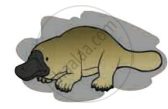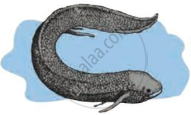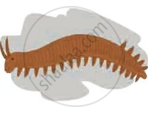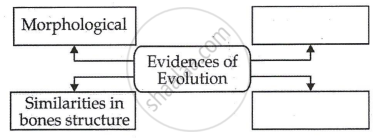Advertisements
Advertisements
प्रश्न
Observe the following images and answer the questions.

- Which evolutionary evidences are indicated in the given picture?
- How are they formed?
- Which method is used to measure their age or their time?
उत्तर
- The given pictures indicate paleontological evidences of evolution.
- Large number of organisms get buried due to disasters like flood, earthquake, volcano, etc. Remnants and impressions of such organisms remain preserved underground and form fossils.
- Carbon dating is a method used to measure the age of fossils.
APPEARS IN
संबंधित प्रश्न
Which of the following pairs of two vegetables represent the correct homologous structures?
(A) Sweet potato and potato
(B) Sweet potato and tomato
(C) Carrot and potato
(D) Radish and carrot
Select two pairs from the following which exhibit divergent evolution. Give reasons for your answer.
(i) Forelimbs of cheetah and mammals
(ii) Flippers of dolphins and penguins
(iii) Wings of butterflies and birds
(iv) Forelimbs of whales and mammals
How analogy and homology considered as an evidence in support of evolution ?
Which of the following is a correct set of homologous organs?
(a) Forelimbs of frog, bird and lizard
(b) Spine of cactus and thorn of bougainvillea
(c) Wings of bat and wings of butterfly
(d) Wings of a bird and wings of a bat
Explain with an example for the given, how the following provides evidence in favor of evolution in organisms :
Fossils
Explain the evolution of giraffe's neck according to Lamarck's theory of evolution.
The forelimbs of a frog, a bird and a man show the same basic design (or basic structure) of bones. What name is given to such organs?
The organs which perform similar functions but have different basic structure are called :
(a) asymmetric organs
(b) analogous organs
(c) homologous organs
(d) homophonic organs
Wing of an insect and forelimb of a bird are :
(a) analogous organs
(b) analeptic organs
(c) homologous
(d) homophobic organs
Some dinosaurs had feathers although they could not fly birds have feathers that help them to fly. In the context of evolution, this means that ______
The wings of a housefly and the wings of a sparrow are an example of :
(a) analogous organs
(b) vestigial organs
(c) respiratory organs
(d) homologous organs
Select a set of homologous organs from the following:
(A) Wings of a bat and wings of a butterfly
(B) Wings of a pigeon and wings of a bat
(C) Wings of a butterfly and wings of a pigeon
(D) Forelimbs of a duck, forelimbs of a cow and forelimbs of a lizard
In a class, students were asked to observe the models/slides/pictures of the skeletons of forelimbs and wings of different organisms. After the observations the students made the following groups of homologous structures. Select the correct group :
(A) Wings of a bird and a butterfly
(B) Wings of a pigeon and a bat
(C) Wings of a butterfly and a bat
(D) Forelimbs of a cow, a duck and a lizard
Vestigial organ ______ present in human body is proof of evolution.
“Appearance of melanised moths post-industrialisation in England is a classic example of evolution by natural selection.” Explain.
With the help of diagrams, describe emasculation and bagging.
Define fossil.
Short answer question.
Give the significance of fossils.
Find an odd one out.
Find an odd one out.
Match the following.
| Column A | Column B |
| 1) Morphological evidences | a) Tail-bone or wisdom teeth |
| 2) Paleontological evidences | b) Leaf venation |
| c) Fossils |
Give scientific reason.
Peripatus is said to be the connecting link between Annelida and Arthropoda.
Observe the given images and answer the following questions.

- Which evolutionary evidence does it indicate?
- What does it prove?
- State another example of evolutionary evidence.
Write the answers to the questions by observing the figure below.
 |
 |
 |
| (a) | (b) | (c) |
- Write the name of the animal ‘(a)’ in the figure.
- Write the name of the animal ‘(b)’ in the figure.
- Write the name of the animal ‘(c)’ in the figure.
- Which evolutionary evidence is illustrated by this figure?
- Write the definition of that evidence for evolution.
Biogenetic law states that ______.
How do you differentiate homologous organs from analogous organs?
Select vestigial organs from the following.
Select the correct statement.
Select the CORRECT set of homologous organs.
Which is not a vestigial organ in a man?
The study of fossil evidence of evolution is called ______
Organs having similar functions but different origin and development are known as:
Which of the following is used as an atmospheric pollution indicator?
Appearance of antibiotic-resistant bacteria is an example of ______.
How do we compute the age of a living tree?
What is the function of the appendix of our digestive system?
Evolutionary convergence is the development of a ______.
Complete the following conceptual picture:

